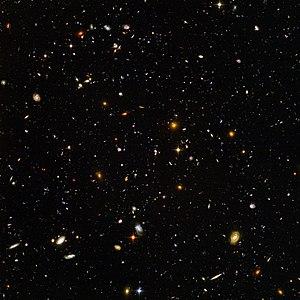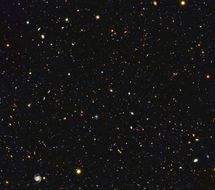
Back Hubble-ultradiepveld Afrikaans حقل هابل العميق الفائق Arabic Hubble Ultra Deep Field Bulgarian Camp ultra profund del Hubble Catalan Hubbleovo ultrahluboké pole Czech Hubble Ultra Deep Field Danish Hubble Ultra Deep Field German Ultra-Profunda Kampo de Hublo Esperanto Campo ultraprofundo del Hubble Spanish Hubble'i ülisüvavaade Estonian

The Hubble Ultra-Deep Field (HUDF) is a deep-field image of a small region of space in the constellation Fornax, containing an estimated 10,000 galaxies. The original data for the image was collected by the Hubble Space Telescope from September 2003 to January 2004 and the first version of the image was released on March 9, 2004.[1] It includes light from galaxies that existed about 13 billion years ago, some 400 to 800 million years after the Big Bang.
The HUDF image was taken in a section of the sky with a low density of bright stars in the near-field, allowing much better viewing of dimmer, more distant objects. Located southwest of Orion in the southern-hemisphere constellation Fornax, the rectangular image is 2.4 arcminutes to an edge,[2] or 3.4 arcminutes diagonally. This is about one-tenth of the angular diameter of a full moon viewed from Earth (less than 34 arcminutes),[3] smaller than a 1 mm2 piece of paper held 1 m away, and equal to roughly one twenty-six-millionth of the total area of the sky. The image is oriented so that the upper left corner points toward north (−46.4°) on the celestial sphere.
In August and September 2009, the HUDF field was observed at longer wavelengths (1.0 to 1.6 μm) using the infrared channel of the recently fitted Wide Field Camera 3 (WFC3). This additional data enabled astronomers to identify a new list of potentially very distant galaxies.[4][5]
On September 25, 2012, NASA released a new version of the Ultra-Deep Field dubbed the eXtreme Deep Field (XDF). The XDF reveals galaxies from 13.2 billion years ago, including one thought to have formed only 450 million years after the Big Bang.[6]
On June 3, 2014, NASA released the Hubble Ultra Deep Field 2014 image, the first HUDF image to use the full range of ultraviolet to near-infrared light.[7] A composite of separate exposures taken in 2002 to 2012 with Hubble's Advanced Camera for Surveys and Wide Field Camera 3, it shows some 10,000 galaxies.[8]
On January 23, 2019, the Instituto de Astrofísica de Canarias released an even deeper version[9] of the infrared images of the Hubble Ultra Deep Field obtained with the WFC3 instrument, named the ABYSS Hubble Ultra Deep Field. The new images improve the previous reduction of the WFC3/IR images, including careful sky background subtraction around the largest galaxies on the field of view. After this update, some galaxies were found to be almost twice as big as previously measured.[10][11]
- ^ Cite error: The named reference
press_releasewas invoked but never defined (see the help page). - ^ "HubbleSite: Categories - news". hubblesite.org. Archived from the original on 2016-11-11. Retrieved 2014-02-26.
- ^ "Moon Illusion". homepages.wmich.edu. Archived from the original on 2017-05-09. Retrieved 2014-02-26.
- ^ "HubbleSite: News - Hubble's Deepest View of Universe Unveils Never-Before-Seen Galaxies". hubblesite.org.
- ^ Bouwens, R.J.; Illingworth, G.D.; Oesch, P.A.; Stiavelli, M.; van Dokkum, P.; Trenti, M.; Magee, D.; Labbe, I.; Franx, M.; Carollo, M.; Gonzalez, V. (2009). "Discovery of z~8 Galaxies in the HUDF from ultra-deep WFC3/IR Observations". Astrophysical Journal. 709 (2): L133–L137. arXiv:0909.1803. Bibcode:2010ApJ...709L.133B. doi:10.1088/2041-8205/709/2/L133. S2CID 118083736.
- ^ "Hubble Goes to the eXtreme to Assemble Farthest-Ever View of the Universe". NASA. September 25, 2012. Retrieved September 26, 2012.
- ^ "IAC PRESS RELEASE - Making the Hubble's deepest images even deeper". Instituto de Astrofísica de Canarias. January 24, 2019.
- ^ "Hubble Ultra Deep Field 2014". HubbleSite.org. Retrieved 2022-01-25.
- ^ "Instituto de Astrofísica de Canarias - IAC - Educational Outreach". www.iac.es. January 24, 2019. Retrieved February 5, 2019.
- ^ Martínez-Lombilla, Cristina; Akhlaghi, Mohammad; Cardiel, Nicolás; Dorta, Antonio; Cebrián, María; Gómez-Guijarro, Carlos; Almagro, Rodrigo Takuro Sato Martín de; Lumbreras-Calle, Alejandro; Infante-Sáinz, Raúl (January 1, 2019). "The missing light of the Hubble Ultra Deep Field". Astronomy & Astrophysics. 621: A133. arXiv:1810.10298. Bibcode:2019A&A...621A.133B. doi:10.1051/0004-6361/201834312. ISSN 0004-6361. S2CID 119232262.
- ^ Borlaff, Alejandro; Trujillo, Ignacio; Román, Javier; Beckman, John E.; Eliche-Moral, M. Carmen; Infante-Sáinz, Raúl; Lumbreras, Alejandro; de Almagro, Rodrigo Takuro Sato Martín; Gómez-Guijarro, Carlos (January 2019). "The missing light of the Hubble Ultra Deep Field". Astronomy & Astrophysics. 621: A133. arXiv:1810.10298. Bibcode:2019A&A...621A.133B. doi:10.1051/0004-6361/201834312. ISSN 0004-6361. S2CID 119232262.
© MMXXIII Rich X Search. We shall prevail. All rights reserved. Rich X Search

